Smart Fabrics: The Future of Fashion and Mobility

What Are Smart Fabrics and Why Do They Matter?
Smart fabrics, also known as e-textiles, are materials that can sense and react to environmental stimuli. Imagine wearing a shirt that can monitor your heart rate or adjust its temperature based on your body heat. This innovative technology is not just a trend; it’s a significant leap forward in how we interact with our clothing.
The future of fashion is not just about what you wear, but how it interacts with your life.
The importance of smart fabrics lies in their potential to enhance our daily lives. They offer solutions for health monitoring, comfort, and even safety, making them invaluable in various fields like sports, healthcare, and fashion. For instance, a smart jacket could alert you to sudden changes in weather, keeping you comfortable and safe.
As fashion evolves, the integration of smart textiles opens up new creative avenues for designers. They can create garments that not only look good but also serve functional purposes, blending style with technology. This fusion is paving the way for a future where clothing is not just worn, but experienced.
The Technology Behind Smart Fabrics
Smart fabrics incorporate a variety of technologies, such as conductive fibers, sensors, and microcontrollers. These elements work together to create textiles that can gather data and provide feedback. Think of them as tiny computers woven into the fabric, ready to respond to your needs.

For example, some smart fabrics can change color or pattern based on your mood or the weather. This is made possible through color-changing dyes or embedded LEDs that react to external stimuli. It’s like having a wardrobe that can express your feelings or adapt to your environment in real-time.
Smart Fabrics Enhance Daily Life
Smart fabrics can monitor health, adapt to the environment, and improve comfort and safety in various fields.
Moreover, the development of these fabrics often involves collaboration between engineers, designers, and healthcare professionals. This teamwork ensures that smart textiles are not only innovative but also practical and user-friendly. The end goal is to create clothing that enhances the wearer's experience while remaining functional and comfortable.
Applications in the Fashion Industry
The fashion industry is embracing smart fabrics in exciting ways, from athleisure to high fashion. For instance, brands are now designing workout gear that can track your performance, helping athletes optimize their training. Imagine wearing leggings that not only fit perfectly but also tell you when it’s time to push harder or ease off.
Wearable technology is not just about looking good; it's about enhancing our everyday experiences.
Moreover, luxury fashion is not left behind. Designers are experimenting with smart textiles to create garments that can change shape or function. A dress that transforms from casual daytime wear to evening elegance with a simple gesture is becoming a reality, showcasing the versatility and adaptability of smart fabrics.
This shift towards smart textiles is also encouraging sustainability in fashion. By creating garments that last longer and serve multiple purposes, the industry can reduce waste and promote a more eco-friendly approach to clothing. This is a win-win for both consumers and the planet.
Enhancing Mobility with Smart Fabrics
Smart fabrics are not just revolutionizing fashion; they are also improving mobility for various communities. For instance, textiles that monitor health metrics can empower individuals with disabilities or chronic conditions to live more independently. These innovations can provide real-time feedback to caregivers, enhancing safety and support.
In sports, smart fabrics are being used to create gear that helps athletes optimize their performance while preventing injuries. For example, a smart shirt can monitor muscle strain and notify the athlete when to rest, reducing the risk of overexertion. This technology is transforming how athletes train and compete.
Fashion Meets Technology
The integration of smart textiles allows designers to create stylish garments that also serve functional purposes.
Additionally, smart fabrics can play a significant role in the development of wearable technology, such as smart clothing integrated with GPS or communication devices. This can be especially beneficial for outdoor enthusiasts and adventurers, providing them with vital information at their fingertips while keeping them stylish and comfortable.
The Role of Smart Fabrics in Healthcare
In healthcare, smart fabrics are proving to be game-changers. Wearable sensors embedded in textiles can monitor vital signs like heart rate, temperature, and even blood glucose levels. This continuous monitoring can lead to early detection of health issues and more personalized healthcare solutions.
For elderly individuals or those with chronic illnesses, smart fabrics can provide peace of mind to both patients and their families. Imagine a shirt that alerts caregivers when a patient’s vitals are out of range, ensuring timely intervention. This technology fosters independence while enhancing safety for vulnerable populations.
Furthermore, these innovations can extend to rehabilitation and therapy, where smart fabrics assist in monitoring recovery progress. A garment that tracks movement can help physical therapists tailor rehabilitation programs to each patient’s needs, promoting faster and more effective recovery.
Challenges Facing Smart Fabrics Development
While the future of smart fabrics is bright, there are challenges that need addressing. One major concern is durability; integrating electronics into textiles can sometimes compromise their lifespan. Ensuring that these smart garments can withstand regular wear and washing is essential for consumer adoption.
Another challenge is the cost. Currently, smart fabrics can be expensive to produce, making them less accessible to the average consumer. As technology advances and production methods become more efficient, we can hope for a decrease in costs, making these innovations available to a wider audience.
Future of Smart Fabrics is Bright
Advancements in technology will lead to more personalized and multifunctional clothing, transforming how we experience fashion.
Lastly, there are concerns regarding data privacy. With smart fabrics collecting personal information, it’s crucial to establish clear guidelines on how this data is used and protected. Building trust with consumers will be a key factor in the widespread acceptance of smart textiles in the market.
The Future of Smart Fabrics: What Lies Ahead?
Looking ahead, the future of smart fabrics is poised to be incredibly exciting. As technology continues to evolve, we can expect to see even more advanced features integrated into textiles, such as improved sensors and energy-harvesting capabilities. Imagine clothing that not only monitors your health but also charges your devices using your body heat.
Moreover, the trend of personalization will likely take center stage. Smart fabrics could adapt to individual preferences, such as adjusting fit or style based on the wearer’s choice. This level of customization could revolutionize the shopping experience, making it more enjoyable and tailored to personal tastes.

Ultimately, the fusion of fashion and technology through smart fabrics holds the promise of a more connected, comfortable, and stylish future. As designers and technologists collaborate, we can anticipate a world where our clothing enhances our lives in ways we’ve only just begun to imagine.